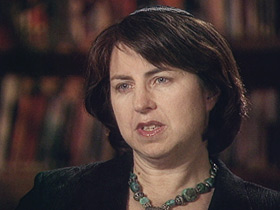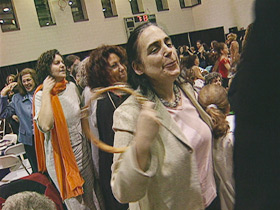In This Episode << SLIDE LEFT TO SEE ADDITIONAL SEGMENTS
Women’s Seder
LUCKY SEVERSON, guest anchor: On our calendar this week, the eight-day Jewish observance of Passover. On Wednesday night, Jews will gather for a Seder, a special dinner, where they retell the story of their ancestors’ exodus from Egypt. The Seder ritual is guided by a special book called the Haggadah. In recent years, in addition to the traditional observance, some Jewish groups have developed Seders with a special focus. This year, Ma’yan, the Women’s Project at the Jewish Community Center of Manhattan, celebrated the tenth anniversary of its feminist Seder. The story from Kim Lawton.
Rabbi JOY LEVITT (reading): Why is this night different from all other nights?

KIM LAWTON: It’s a Passover Seder — but one quite different from most traditional Seders. This one recounts the children of Israel’s exodus from slavery in Egypt from the perspective of women.
Rabbi LEVITT (Jewish Community Center, New York City) : A feminist Seder attempts to locate women in that story, not only the story of the liberation of the Israelites in Egypt but the continuing, evolving story of liberation of women everywhere.
Rabbi LEVITT (reading with unidentified woman): What do we cleanse ourselves of tonight? The exhaustion of cleaning and cooking. The echo of exclusionary language. The weight of history. The fear of women’s voices.
LAWTON: The feminist ritual is guided by a specially written Haggadah — or text — which uses feminine language for God. Daughters, instead of sons, ask the Four Questions, which help tell the story.
Rabbi LEVITT: It’s important for every Jew to make this ritual his or her own. That’s the commandment that the rabbis bestow on us — that one needs to feel this experience personally
LAWTON: The feminist Passover meal includes traditional symbolic foods such as unleavened bread, or matzoh; hard-boiled eggs; and bitter herbs. And something very nontraditional — an orange. Organizers aren’t sure exactly why the custom began — some say it symbolizes inclusion of gays and lesbians. Others say it’s in response to a man who once said the idea of a female rabbi was as ridiculous as an orange on a Seder plate.
In the feminist Seder, Moses’s sister Miriam plays a key role.
Rabbi LEVITT: She was a source of great energy, power, comfort, and nourishment to the Israelites as they made their way out of Egypt.
LAWTON: In the traditional Seder, there is a cup of wine for the Prophet Elijah, who many Jews believe will herald the Messianic Age. In this meal, there’s also Miriam’s Cup, which is filled with water.

Rabbi LEVITT: I like to think of Elijah’s cup as the cup that symbolizes the future, whereas I think Miriam’s cup really symbolizes the present. We wait for Elijah, but we work with Miriam.
LAWTON: According to the Bible story, Miriam celebrated the exodus from Egypt with singing, dancing, and tambourine playing — a hallmark of every feminist Seder.
The ritual details may be different, but organizers say they are celebrating the enduring Passover theme of liberation.
Rabbi LEVITT: The message of the Seder really is that I can’t be free unless you are. And my responsibility is to work for your freedom just as your responsibility is to work for mine.
LAWTON: I’m Kim Lawton reporting.

